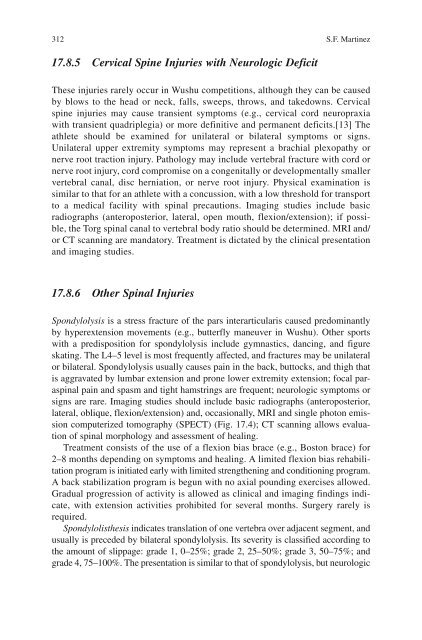Nutrition in Combat Sports
Nutrition in Combat Sports
Nutrition in Combat Sports
You also want an ePaper? Increase the reach of your titles
YUMPU automatically turns print PDFs into web optimized ePapers that Google loves.
312 S.F. Mart<strong>in</strong>ez<br />
17.8.5 Cervical Sp<strong>in</strong>e Injuries with Neurologic Deficit<br />
These <strong>in</strong>juries rarely occur <strong>in</strong> Wushu competitions, although they can be caused<br />
by blows to the head or neck, falls, sweeps, throws, and takedowns. Cervical<br />
sp<strong>in</strong>e <strong>in</strong>juries may cause transient symptoms (e.g., cervical cord neuropraxia<br />
with transient quadriplegia) or more def<strong>in</strong>itive and permanent deficits. [13] The<br />
athlete should be exam<strong>in</strong>ed for unilateral or bilateral symptoms or signs.<br />
Unilateral upper extremity symptoms may represent a brachial plexopathy or<br />
nerve root traction <strong>in</strong>jury. Pathology may <strong>in</strong>clude vertebral fracture with cord or<br />
nerve root <strong>in</strong>jury, cord compromise on a congenitally or developmentally smaller<br />
vertebral canal, disc herniation, or nerve root <strong>in</strong>jury. Physical exam<strong>in</strong>ation is<br />
similar to that for an athlete with a concussion, with a low threshold for transport<br />
to a medical facility with sp<strong>in</strong>al precautions. Imag<strong>in</strong>g studies <strong>in</strong>clude basic<br />
radiographs (anteroposterior, lateral, open mouth, flexion/extension); if possible,<br />
the Torg sp<strong>in</strong>al canal to vertebral body ratio should be determ<strong>in</strong>ed. MRI and/<br />
or CT scann<strong>in</strong>g are mandatory. Treatment is dictated by the cl<strong>in</strong>ical presentation<br />
and imag<strong>in</strong>g studies.<br />
17.8.6 Other Sp<strong>in</strong>al Injuries<br />
Spondylolysis is a stress fracture of the pars <strong>in</strong>terarticularis caused predom<strong>in</strong>antly<br />
by hyperextension movements (e.g., butterfly maneuver <strong>in</strong> Wushu). Other sports<br />
with a predisposition for spondylolysis <strong>in</strong>clude gymnastics, danc<strong>in</strong>g, and figure<br />
skat<strong>in</strong>g. The L4–5 level is most frequently affected, and fractures may be unilateral<br />
or bilateral. Spondylolysis usually causes pa<strong>in</strong> <strong>in</strong> the back, buttocks, and thigh that<br />
is aggravated by lumbar extension and prone lower extremity extension; focal parasp<strong>in</strong>al<br />
pa<strong>in</strong> and spasm and tight hamstr<strong>in</strong>gs are frequent; neurologic symptoms or<br />
signs are rare. Imag<strong>in</strong>g studies should <strong>in</strong>clude basic radiographs (anteroposterior,<br />
lateral, oblique, flexion/extension) and, occasionally, MRI and s<strong>in</strong>gle photon emission<br />
computerized tomography (SPECT) (Fig. 17.4 ); CT scann<strong>in</strong>g allows evaluation<br />
of sp<strong>in</strong>al morphology and assessment of heal<strong>in</strong>g.<br />
Treatment consists of the use of a flexion bias brace (e.g., Boston brace) for<br />
2–8 months depend<strong>in</strong>g on symptoms and heal<strong>in</strong>g. A limited flexion bias rehabilitation<br />
program is <strong>in</strong>itiated early with limited strengthen<strong>in</strong>g and condition<strong>in</strong>g program.<br />
A back stabilization program is begun with no axial pound<strong>in</strong>g exercises allowed.<br />
Gradual progression of activity is allowed as cl<strong>in</strong>ical and imag<strong>in</strong>g f<strong>in</strong>d<strong>in</strong>gs <strong>in</strong>dicate,<br />
with extension activities prohibited for several months. Surgery rarely is<br />
required.<br />
Spondylolisthesis <strong>in</strong>dicates translation of one vertebra over adjacent segment, and<br />
usually is preceded by bilateral spondylolysis. Its severity is classified accord<strong>in</strong>g to<br />
the amount of slippage: grade 1, 0–25%; grade 2, 25–50%; grade 3, 50–75%; and<br />
grade 4, 75–100%. The presentation is similar to that of spondylolysis, but neurologic

















